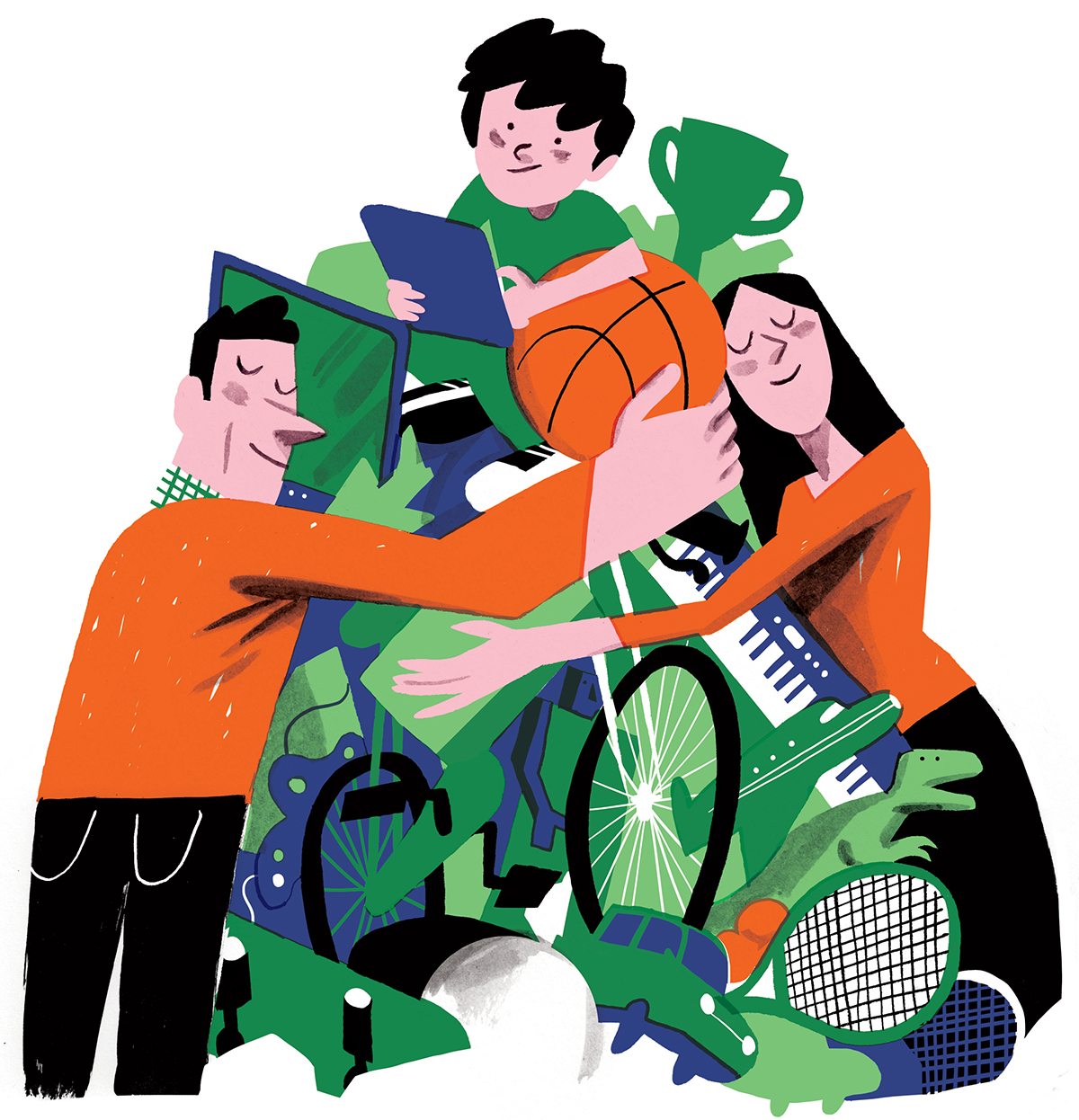Spoiled Rotten

Illustration by João Fazenda
The halftime buzzer sounded just as the boy tossed the ball toward the basket. It arced gracefully through the air and swished through the net. While all of his teammates jumped up and cheered, the boy looked over at his father anxiously and called across the court, “Dad, does that count?” His father, seated beside me on the bleachers, nodded imperceptibly—and only then did the nine-year-old pump his fist and shout, “Yessss!”
There was something a little off about this exchange I witnessed between father and son at my boys’ basketball game this winter. But it didn’t click until months later, when my son asked me out of the blue, “Mom, will you pay me if I score in my soccer game today?”
“Excuse me?”
“Joshua told me his dad gives him a dollar if he gets a goal,” he said between mouthfuls of cereal.
I looked at him in disbelief. “Absolutely not.”
He thought about that for a moment and shrugged. “I thought that’s what you’d say,” he remarked, then returned to his breakfast.
At the soccer game, I made a beeline for the other mothers on the sidelines. “Are parents really paying their children for goals?”
“Yes,” answered a mom of three boys.
“But why?”
“To encourage their child to be competitive,” explained another. The hope is that once the kid gets a taste of success, he or she will develop his or her own inner motivation. And it’s not just limited to goals or baskets: “I know a family that pays their kids more if they make the A team, less for the B and C, and pittance for the D team,” a hockey mom tells me.
Um, what about simply nurturing a love of the sport the old-fashioned way? Emphasizing the importance of dedication, hard work, and persistence? The concept of intrinsic motivation?
Have we lost our minds?
The answer is yes. And not just because we’re paying cash for goals. We’re bribing our children to get in their car seats, to stay in that grocery cart, to pick up their toys, to get As on their report cards. It may pale in comparison to the “wife bonus” being handed out in affluent marriages—according to a recent New York Times story—but the child bonus is just as insidious. We’re forking over as much as $113 a month in “allowances, bribes, rewards, and gifts” just to get them to do what we ask, according to a survey conducted by the website Vouchercloud last year. What’s more, we’re lavishing them with inflated praise and acting like their BFFs instead of their parents.
Where have we gone wrong?
I ask myself that nearly every day as I fight an exhausting battle against my children’s rising sense of entitlement—“buy me…gimme…take me.” Even after an amazing day at Canobie Lake Park, my kids will find something to fixate on during the car ride home: Why didn’t I buy them slushies? Why couldn’t they have a stuffed animal from the gift shop? If one of our toys breaks, my son will say, “That’s all right, we’ll just buy a new one.” My five-year-old is distraught because her birthday party will be in our backyard, while her friends have theirs at fancy gymnastics centers or indoor play facilities—to the tune of $300 or more.
Parents all over the country are struggling with these issues, and it’s not just in affluent communities. According to a 2012 article in the New Yorker, two-thirds of us think our kids are spoiled.
But why is it so different now than when we were growing up? We can point to peer pressure, rampant materialism, pop culture, and the media, but the truth is: It’s our doing. And it’s high time we own up to it.
Richard Weissbourd blames our obsession with our children’s happiness. “We live in an extraordinarily child-centered age”—different than almost any other period in history, says Weissbourd, a psychologist and senior lecturer at the Harvard Graduate School of Education, and author of the book The Parents We Mean to Be. Its origins can be traced back to the late 1980s, when a California state assemblyman declared self-esteem a “social vaccine,” capable of strengthening children and making them less vulnerable to negative behaviors. Suddenly, self-esteem was being hailed nationwide as the key to happiness and the answer to almost every social and moral problem you could shake a stick at. If you make a child feel good about himself, the thinking went, he’ll get good grades, he won’t do drugs or commit crimes, and he’ll be a contributing citizen. Who wouldn’t want that for their kid? Weissbourd says he sometimes hears an almost religious faith in the powers of self-esteem in conversations with parents and teachers around the country.
But the problem is that in elevating the goals of achievement, self-esteem, and happiness, “so much attention has been paid moment to moment on our kids’ feelings that we have sidelined caring for other people and respect,” Weissbourd says. It used to be that parents’ primary role was to raise good citizens, he says. Likewise, schools and religious institutions were focused on developing children’s ethical character. Now teachers are discouraged from using red ink (too negative!) and marking wrong answers with an X (check marks on the correct ones will suffice). We’re all about “pumping [our] kids with praise,” Weissbourd says.
That may seem harmless, but according to one recent study, kids are more likely to show narcissistic traits when their parents shower them with praise. The authors of the study concluded that “parents can convey affection and appreciation to children without conveying…that they are superior to others.” Obvious? Perhaps. But is it possible we’re doing it unconsciously? After all, how many times have we told our children, “Wow, you’re the best jump-roper/skipper/finger-painter” without giving it a second thought?
And anyway, it turns out that all of this praise is not actually making our children happier. A startling percentage of college students are dealing with depression. The terms used by college administrators are “tea cups” and “crispies”—kids that are too fragile or too brittle to withstand the stresses of college life. Weissbourd attributes this in part to an “allergy to adversity” that moms and dads have these days. “If parents swoop in to [solve a problem], it robs [their kids] of coping skills,” he says. To wit: A local mom pulled her 10-year-old out of her school’s music class entirely when she complained that the teacher was mean to her and made her cry. A fellow mother at the school tells me that the woman takes her daughter out to lunch during the weekly music period instead. “Kids should be shown the tools to learn to manage situations like these on their own,” she says.
Fast-forward a few years to when the participation-trophy generation enters the workforce, and they’re in for a reality check. My friend Josh tells me about a young sales rep he hired that consistently performed average to below average. Yet when it came time for his review, he ranked himself as “one of the top salesmen” in the company. Josh had to show him his sales figures in comparison to the other sales reps before he finally understood that he was mediocre. “This news practically floored him,” Josh says, “and he showed visible signs of getting choked up during the review.” He was surprised because he felt that he had “showed up to work by a certain time, participated in meetings, and got along really well with others”—but he’d “failed to include a single example of, and objective measure of, sales success.” Josh says that “the biggest disservice done to these kids was that they were never taught the difference between winning and losing. They were shielded from the harsh realities of the real world.”
We’re a generation of nurturers producing a generation of people ill equipped to handle life’s slings and arrows. That’s why Weissbourd and his colleague founded the Making Caring Common Project through Harvard in 2012. According to its website, the group offers “effective strategies for promoting in children kindness and a commitment to the greater good.” One of the most promising ways to promote joy is “to tune into other people,” Weissbourd asserts. “Those are the most durable and robust sources of happiness you can have.”
It can be as simple as reminding your children to write thank-you notes, or telling them to reach out to a kid playing by himself on the playground, or not letting them quit a team because others are counting on them. Weissbourd suggests encouraging kids to expand their “circle of concern,” typically family and friends, to include classmates and people they see regularly—the bus driver, for example, or the school janitor. Emphasize that they should be friendly and appreciative. “You have to be deliberate about it,” he says.
Weissbourd says he gets very little resistance from parents on this topic. There’s generally a consensus that “we’re out of balance.” In one of the studies conducted by the Making Caring Common Project, Weissbourd and his associates asked kids what they think is most important to their parents: their child’s achievement, their happiness, or their ability to care for others. Kids were three times more likely to say that they thought getting good grades ranked higher. Yet other research has revealed that most parents answer that caring is more important. It shows that “there’s a significant gap between what parents are saying and what they convey in their day-to-day behavior,” Weissbourd says.
The issue is that our children lack perspective, says one mother I talked to. They’re sheltered. So when they cry out, “It’s not fair!” they have no idea what unfairness actually looks like. To them, taking away their iPad after 20 minutes is supremely unfair. Is that their fault—or ours?
My neighbor Kate Walsh was looking for perspective when she signed her family up for an Oxfam hunger banquet at her church last winter. “My kids were asking why we didn’t have a vacation home, or why we didn’t travel more,” explains Walsh, a pediatrician who works with an underprivileged community in Worcester.
She invited me to join them at the dinner. When we arrived, we drew tickets that were randomly assigned to a high-, middle-, or low-income tier. Each income level receives a corresponding meal—filling and nutritious, or sparse and simple—in proportion to the way food is distributed throughout the world. There was just one high-income table, three middle-income, and five low-income. Before we dug in, the moderator asked the group, “What do you think you need to earn annually to be at the high-income table?” We looked over at the eight people who’d been served lasagna, French bread, salad, ice water with lemon, and wine. Meanwhile, the low- income folks were lined up in the back of the room to get a scoop of white rice and a glass of tap water.
“$75,000?” one woman guessed. I nearly choked on my rice and beans. Um, we were talking worldwide, not just wealthy suburban Boston enclaves. “$12,000,” the moderator answered. Maybe we could all use a little more perspective?

